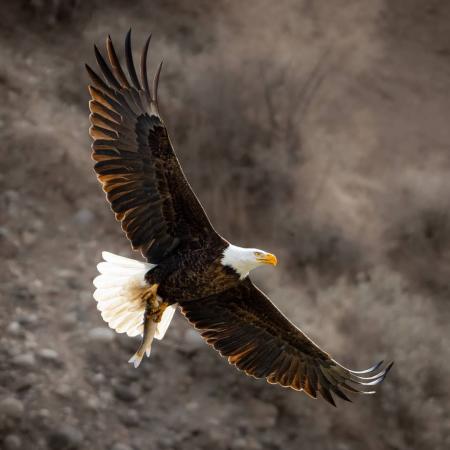Mesa County is the fourth largest county in Colorado, by land mass, and is 76 percent public land, so wildlife has the benefit of roaming free without being squeezed out by urban sprawl, like much of the state. Grand Junction is located in Mesa County and is populated with numerous unique wild species. From the iconic bighorn sheep to the discreet canyon tree frog. The opportunities to spot local wildlife are bountiful, particularly along the trails of the Colorado National Monument. However, when you go wildlife exploring, there are precautions to be aware of in order to keep yourself and the animals safe, while also protecting the environment. Check out what you need to know about seeing animals in Grand Junction and staying safe while doing so.
Where to See Animals in Grand Junction
While it is common to see wildlife within the city, you’ll increase your odds of an animal sighting by going slightly further into nature. Fortunately, you don’t have to go very far because Grand Junction is the intersection of many diverse ecosystems that countless species thrive in. From the mighty Colorado River and multiple state parks to the Colorado National Monument and the Grand Mesa National Forest – deer, moose, over 200 bird species, bighorn sheep, trophy elk, and other game abound. There is even a moose herd on the Grand Mesa with a population of more than 120.
Head over to the Colorado National Monument, less than 6 miles or 10 minutes from Downtown Grand Junction, and immerse yourself in one of the world’s most unique environments. This majestic landscape is part of the National Park Service (NPS) and is coined “The Heart of the World.” The sandstone canyons and semi-arid climate are the ideal setting for many species of birds, reptiles, amphibians, and mammals, including the regal desert bighorn sheep. Depending on the time of year, you’re bound to see a number of birds and lizards along the Devil’s Kitchen Trail in the Colorado National Monument. This moderate hike takes only an hour to complete and leads you to a unique collection of towering rock formations known as “Devil’s Kitchen.” Another hike to consider in the Colorado National Monument is the 11.5-mile Monument Canyon Trail, which is popular for its stunning views and desert bighorn sheep sightings.

Located just outside of the James M. Robb Colorado State Park in Grand Junction, the Audubon Nature Preserve is a celebrated destination for wildlife enthusiasts. Sightings include osprey, eagles, foxes, herons, owls, deer, frogs, fish, and more. Continue along the Colorado Riverfront Trail from the Audubon Nature Preserve into the neighboring James M. Robb Colorado State Park for additional opportunities to see wildlife in their protected habitats.
Colorado Animals
Various species of deer, foxes, feline predators, rabbits, squirrels, reptiles, eagles, and songbirds thrive in Colorado’s diverse environments. From the rugged Rocky Mountains and the grassy plains to the dramatic canyons of Western Colorado, here are some of the most notable species that thrive in Grand Junction:
Desert Bighorn Sheep
Native to Western Colorado, the desert bighorn sheep is the cousin of Colorado’s state animal, the rocky mountain bighorn sheep. The regal mammal is adapted for dry environments (going days without water!) and is known for its large, curved horns. If you see one while hiking in the Colorado National Monument, make sure to give it space and observe from a distance.
Mule Deer
What has a black forehead, big ears, and is emblematic of the American West? The mule deer, of course. You’re likely to see herds of mule deer across Western Colorado, grazing on shrubs and other vegetation.
Golden Eagle
Keep your eyes peeled for the golden eagle, whose impressive wingspan can spread up to seven feet. The acrobatic raptor soars through the sky hunting for small prey animals. They often build their nests on cliffs or in trees, so keep your eyes peeled.
Bobcat
The bobcat, or red lynx, lives across the state of Colorado, including Grand Junction. The medium-sized feline species is distinguished by its short stubby tail and spotted fur. They tend to live around trees and hunt for small prey animals, like rabbits and birds. Bobcats are not known to attack people; however, if one approaches you, make noises by yelling and clapping your hands and back away. At this point, they will likely move away as they are rather skittish around humans.
Eastern Collared Lizard
Also referred to as the “mountain boomer”, the Eastern collared lizard is easily recognized by its colorful spotted body, yellow head, and two black collars. You can find them sunbathing on the rocks in the Colorado National Monument or hunting for insects. As with all wild animals, please do not touch them because these lizards can bite!
Pinyon Jay
You can catch a glimpse of the striking blue pinyon jay feasting on the seeds of a pinyon pine or sitting on the branches of a juniper tree. Aside from their blue plumage, these medium-sized birds are recognizable by their high-pitch squawk-like call.
Coyote
The coyote is a highly adaptable species that has found a variety of ways to live near populated areas across North America. This canine animal is clever and has a distinctive howl. Coyotes are predators and while they tend to hunt for small wildlife, they can pose a danger to pets and humans. If you see a coyote close by, remain calm, keep eye contact and slowly back away while leaving the area. Do not turn and run, as you may trigger its predatory response, which could engage a chase. Blowing a whistle or yelling in an authoritative voice can scare them away.
Canyon Tree Frog
You are more likely to hear this North American amphibian than see it. The canyon tree frog is a small, very well-camouflaged creature that lives in rocky environments. Listen for its croak in the evenings around Grand Junction.
Elk
The Uncompahgre Plateau is remote and vast, lush with aspen groves, ponderosa forests and red rock canyons. The diverse landscape abounds with herds of elk, as well as desert bighorn sheep. Unit 61 is known as one of the best trophy bull elk areas in Colorado. Grand Mesa Uncompahgre and Gunnison National Forests include populations of over 55,000 elk; 150,000 mule deer; 500 Rocky Mountain bighorn sheep; and 150 desert bighorn sheep. Canada lynx, black bear, pine marten (weasel family), mountain lion, and other small mammals thrive in this area as well.
Wildlife Safety Tips
When you encounter any wildlife in nature, it’s important to remember that you are in their home and should therefore treat them and their environment with respect. There are safety measures you should take while viewing wildlife responsibly. A scared or threatened animal—particularly if it’s a large mammal or predator species—can react aggressively and potentially cause harm to you or others. Here are some tips you should know and follow when heading out into the wilderness.
- Keep a safe and responsible distance; in fact, this is true for all Colorado wild animals. If you would like to see the animals up close, consider bringing a pair of binoculars with you.
- Familiarize yourself with local species’ mating seasons. Males tend to become aggressive during mating season, while females are highly protective of their young, so it’s important to give animals extra space during these times.
- Store food properly. Make sure food is packed away while you’re in the wild and disposed of responsibly. Feeding wild animals—even accidentally—can break down the natural barriers that exist and put both humans and wildlife at risk.
- Use your zoom. Avoid the temptation of approaching wild animals for a better photo and instead activate your zoom feature.
- If there are potential predators nearby, make your presence known. Talking loudly or bashing two sticks together while on a trail will tell mountain lions, coyotes, bobcats and other dangerous species to stay away. If you are hoping to spot other species, like birds, silence is recommended.
- Leave no trace. This means staying on trails, disposing of trash properly, no vandalizing, and respecting wildlife. You can read more about the leave-no-trace philosophy here.
It’s no surprise that wildlife and nature enthusiasts flock to Grand Junction. The diversity of flora and fauna as well as the incredible hiking opportunities and jaw-dropping views make Western Colorado a truly unique place to visit. Get ready for your next trip to Grand Junction using the Official Grand Junction Visitor Guide.











